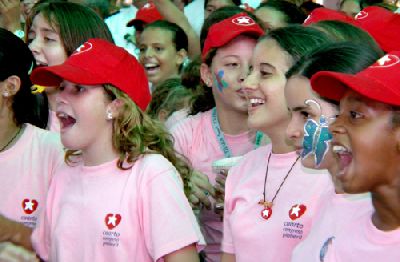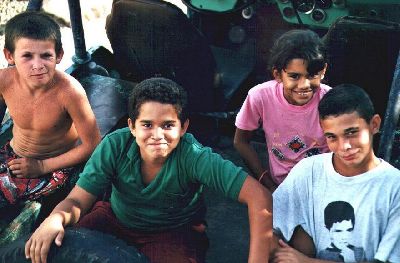Baltimore IMC : http://www.baltimoreimc.org
News :: Activism : Children : Civil & Human Rights : Culture : Peace
From CUBA with LOVE
A School, a Teacher, and a Girl...
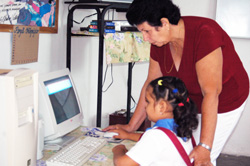
A School, a Teacher, and a Girl
7 January, 2008
FREDDY PEREZ CABRERA
At Las Lechugas, a remote community in the municipality of Camajuani, there’s nothing more important than the school, a beautiful facility that looks like a dollhouse instead of an educational institution. There, Julia Ferreiro, the teacher, and Rachel Marian Rovira, a little girl that’s her only student, are like family.
THE SCHOOL
Twenty kilometers from the small city of Camajuaní, in the central Cuban province of Villa Clara, we find Las Lechugas. The only way to get there is by a narrow road surrounded by dense vegetation. People travel mainly by bicycle or on horseback.
The community has 26 houses and a total population of 65. The main store is located in the center of the town facing the Community Center and the Television and Video Club. Next to the latter, we find the Abel Roig School, in a small 4 by 5 meter building. It’s one of the 34 schools in Villa Clara with only one student (more than 200 schools with only one student in Cuba).
Four small tables make up the classroom –one for the girl, one for the teacher, another one for the many books, especially for books by Martí and children’s literature, and a fourth one for Rachel’s favorite tool: the computer. Next to it, on a shelf, is a 29 inch TV set and video. All the equipment work thanks to the installation of two solar panels on top of the school’s roof.
Chess games, balls for playing volleyball, basketball and soccer are also in the room.
THE TEACHER
Julia Ferreiro’s day begins very early. At 5:00 a.m., she’s already up at Vueltas, where she was born. At that time, she does the household chores and, once she finishes, she heads for the bus stop to try to get a lift that brings her closer to the school.
After a short stopover in Palenque, a town located on the side of the road that joins Camajuaní with Remedios, she takes the bike she keeps at a neighbor’s house to make her trip to Las Lechugas easier. There, Rachel Marian keenly awaits her arrival.
Locals say that in her 31 years of work in the community, Julia has never been late. Many times, in fact, she has arrived soaking wet with rain, but she always comes, acknowledges Marina Mena. And like her, all express their approval of the work accomplished by the teacher.
It is hard to find a family that hasn’t had one of its members taught by Julia. Most of the time, both parents and the children have been educated by her, like in the case of Ania Guzman and Raidel, Rachel’s mother and brother.
The words and character of this woman reflect great humbleness and nobility. She recalls the traveling teachers Marti praised so much in his works.
"Sometimes, the bicycle tires me out a little. Then, I walk for a while and ride again, but I get there and give my classes," says the teacher. Although she has a passion for Math, she studies all subjects equally, in order to be able to pass on the knowledge children need.
When asked if it’s not boring to teach just one student, she said the process is more complex, but that it also has something special.
"You have to rise to the challenge, so communication flows and the class does not lose its rhythm. From the time I plan the subject and on my way here, I ask myself what I can do so the class is different, and I always find a formula. I often use anecdotes, stories and games. In this way I break the routine, and this has brought us good results," explains the teacher.
Julia admits that now, with the audiovisual tools the Revolution has put in her hands, everything is simpler. She sees them as aids which, properly used, greatly enhance the student’s possibility of learning, and make the work of educators easier.
Seven year old Rachel praises her teacher. "She’s very good to me and teaches me a lot. I don’t want her to ever leave this place." And when asked what she wants to be when she grows up, Rachel replies without hesitation: "A teacher, just like her." No recognition could be greater than that.
THE GIRL
Rachel Marian arrives at her school with a bunch of flowers for Jose Marti in her little hands. The day begins with the solemn ceremony of hoisting the flag and paying tribute to the National Hero.
The day we visited the school was December 7, so the class began with an activity in honor of Antonio Maceo, one of the top leaders of Cuba’s independence wars, who died on this date in 1896. While telling anecdotes related to the Maceo-Grajales family, the computer screen showed sentences and phrases about him.
At Julia’s request, the girl drew a Cuban flag, showing an amazing command of the mouse and the computer program.
Since it was a special day, the class was conceived differently. On the table were Rachel’s favorite book, The Golden Age, by Martí, and the Marti Exercise Book for elementary school. The characters of Nene Traviesa, Meñique, Bebe, among the ones created by Jose Marti —an excellent poet and writer—, are familiar to the girl. The teacher also speaks about some of the heroic deeds originating as a result of Cuba’s internationalism.
During recess, Rachel, who up until then was concentrated on Julia’s explanations, pauses to send a message: "I want to send a kiss to Fidel, so he gets well. He has given me all these things I have."
www.granma.cubaweb.cu/english/news/art75.html
Cuba Maintains 5.3 Infant Mortality Rate in 2007
JOSE A. DE LA OSA
For the second consecutive year Cuba recorded an infant mortality rate of 5.3 per 1,000 live births, the lowest in the country’s history and after Canada the lowest in all of the Americas.
Experts note that the true measuring stick of a nation is the way it cares for its children, their health and protection, material security, education and socialization. The infant mortality rate is an indicator of these advances and of the fundamental human right to healthcare.
The worldwide infant mortality rate is 52 per 1,000 live births. In Latin America the figure averages 26 while in West Africa the rate is 108, according to statistics from the 2007 UNICEF State of the World’s Children report.
The industrialized countries have a combined rate of 5. The United States recorded 6 —double the figure registered by the countries with the lowest rates (Sweden, Denmark, Finland, Norway, Japan)— with gross inequalities along ethnic lines. For example, non-Hispanic blacks have an infant mortality rate of 13, considerably higher than any other ethnic or racial group. In Cuba there are no such differences.
According to preliminary infant mortality data presented by officials at the Cuban Mother Child Program and the statistics office of the Ministry of Public Health, six provinces were under the national average: Holguin and Havana City (5.0), Las Tunas and Matanzas (4.4), Camaguey (4.2), and Sancti Spiritus (4.1).
Of the country’s 169 municipalities, 21 recorded a zero infant mortality rate during 2007: Candelaria, Minas de Matahambre, Melena del Sur, Nueva Paz, Bauta, Pedro Betancourt, Union de Reyes, Ciénaga de Zapata, Calimete, Cifuentes, Yaguajay, Taguasco, Florencia, Najasa, Manatí, Colombia, Antilla, Cauto Cristo, Salvador, Imias and Manuel Tames.
During the year there were 112,425 births registered in Cuba —1,102 more than in 2006—, of which 592 died, mainly due to perinatal conditions, congenital anomalies and infections.
While the use of ultrasound and alpha-fetoprotein testing takes place throughout Cuba, it isn’t possible to detect all of the cases of congenital deformations. Internationally, such tests are considered 80 percent accurate.
MOTHER AND CHILD CARE
The pre-revolution infant mortality rate in Cuba was 60 per 1,000 live births. With the deplorable sanitary conditions inherited by the revolution, in 1962 alone, 3.000 children under one year died due to diarrhea induced complications. At the time the infant mortality rate was 42.
A look at the last five decades shows how the revolutionary government prioritized care for mothers and children despite the criminal US blockade and economic war against Cuba.
Today, a half million women die each year around the globe during pregnancy, delivery and post-delivery —one every minute or 400 per 100,000 births. In Latin America that figure is 190 and only 21 in Cuba and due to hemorrhaging, embolism of the amniotic liquid (when spreading to the bloodstream) and clotting.
The low infant and maternal mortality rates came out of a colossal education effort that began with the national literacy campaign, establishing a healthcare system free and accessible to the entire population, the massive vaccination campaigns, and other advances which made possible the accomplishments of the country’s revolution in health.
Another important factor has been the development of family planning programs based on the reproductive right of women to freely choose the number of children they wish to have. Prenatal care includes 17 check ups and in Cuba 99.9 percent of the births take place in maternity hospitals, the only exceptions being those births that take place on route to the hospital.
After being diagnosed as pregnant in the early weeks of pregnancy, eight lab tests are carried out during the first doctor’s visit including those for syphilis and HIV/AIDS which are also done on the partner.
INFANT MORTALITY BY PROVINCE
(THE LAST THREE YEARS COMPARED TO THE RATES IN 1990, 1995 AND 2000)
Province 1990 1995 2000 2005 2006 2007*
Pinar del Rio 8.3 10.2 5.9 5.6 5.0 5.3
Havana 9.8 9.8 7.6 5.7 6.1 5.6
City of Havana 10.0 9.7 7.5 6.6 4.9 5.0
Matanzas 12.0 9.0 6.4 4.0 4.3 4.4
Villa Clara 7.6 7.1 5.0 4.2 4.6 5.5
Cienfuegos 9.9 6.5 5.4 7.0 5.7 7.1
Sancti Spiritus 7.7 8.5 6.2 7.9 6.8 4.1
Ciego de Ávila 11.6 9.2 8.1 5.1 9.0 7.0
Camaguey 11.4 9.2 7.0 8.0 4.3 4.2
Las Tunas 12.9 9.9 7.0 6.4 4.7 4.4
Holguin 12.0 8.7 7.3 4.5 3.8 5.0
Granma 13.6 10.9 8.2 6.6 4.4 5.3
S. de Cuba 11.4 10.2 8.7 7.2 7.9 5.9
Guantanamo 10.8 10.0 9.1 8.0 4.8 6.0
I. de la Juventud 10.4 10.7 4.9 3.7 7.3 5.3
NATIONAL 10.7 9.4 7.2 6.2 5.3 5.3
Source: National Statistics Office of the Ministry of Public Health (MINSAP) Preliminary Data
INFANT MORTALITY IN CUBA 1960-2007
Year <1st year Year <1st year
1960 37.3 1984 15.0
1961 39.0 1985 16.5
1962 41.7 1986 13.6
1963 38.1 1987 13.3
1964 37.8 1988 11.9
1965 37.9 1989 11.1
1966 37.3 1990 10.7
1967 36.4 1991 10.7
1968 38.3 1992 10.2
1969 46.7 1993 9.4
1970 38.7 1994 9.9
1971 36.1 1995 9.4
1972 28.7 1996 7.9
1973 29.6 1997 7.2
1974 29.3 1998 7.1
1975 27.5 1999 6.5
1976 23.3 2000 7.2
1977 24.9 2001 6.2
1978 22.4 2002 6.5
1979 19.4 2003 6.3
1980 19.6 2004 5.8
1981 18.5 2005 6.2
1982 17.3 2006 5.3
1983 16.8 2007 5.3
Source: National Statistics Office of MINSAP
www.granma.cubaweb.cu/english/news/art45.html
Almost Two Thousand Organizations in Solidarity with Cuba Around the World
Havana, Jan 7 (acn) There are almost two thousand organizations in solidarity with Cuba around the world.
Cuban News Agency
Cuban News Agency
The announcement was made on Saturday by Pedro Olmedo, head of the Europe Department at the Cuban Friendship Institute (ICAP) during a farewell ceremony with the members of the 48th contingent of the Nordic Brigade, comprised of 150 people from 11 European countries who stayed for three weeks on the island carrying out voluntary work and visiting places of social and historic interest in the provinces of Havana City, Havana and Holguin.
Olmedo noted that since its very creation in 1970, this brigade has supported the Cuban Revolution and has accompanied Cuba in its struggle against the US economic blockade.
Speaking of the worldwide solidarity movement, Olmedo said that one of the main tasks of these groups is to fight for the release of the five Cuban anti-terrorist fighters who remain unjustly imprisoned in the United States.
On this regard, brigade members agreed to send letters of support to Antonio Guerrero, Fernando Gonzalez, Gerardo Hernandez, Ramon Labañino and Rene Gonzalez - internationally known as the Cuban Five -, who were arrested more than nine years ago for infiltrating anti-Cuba terrorist organizations in South Florida.
They will also write to the US Government denouncing this injustice and demanding the release of the Cuban Five.
www.cubanews.ain.cu/2008/0107organizacionesolidaridad.htm
See also:
www.elacm.sld.cu
www.cuba-humanidad.org
www.cubacoop.com
www.saludthefilm.net/ns/index.html
18thcubacaravan.blogspot.com/
www.ifconews.org
www.cubainformacion.tv/
www.cubanradio.cu
www.antiterroristas.cu/index.php
www.freethefive.org
In Great Britain and Ireland:
www.cuba-solidarity.org.uk/
www.ratb.org.uk/
www.cubansarecoming.org/
www.cubasol-manch.org.uk/
www.cymru-cuba.cjb.net/
www.cubasupport.com/
7 January, 2008
FREDDY PEREZ CABRERA
At Las Lechugas, a remote community in the municipality of Camajuani, there’s nothing more important than the school, a beautiful facility that looks like a dollhouse instead of an educational institution. There, Julia Ferreiro, the teacher, and Rachel Marian Rovira, a little girl that’s her only student, are like family.
THE SCHOOL
Twenty kilometers from the small city of Camajuaní, in the central Cuban province of Villa Clara, we find Las Lechugas. The only way to get there is by a narrow road surrounded by dense vegetation. People travel mainly by bicycle or on horseback.
The community has 26 houses and a total population of 65. The main store is located in the center of the town facing the Community Center and the Television and Video Club. Next to the latter, we find the Abel Roig School, in a small 4 by 5 meter building. It’s one of the 34 schools in Villa Clara with only one student (more than 200 schools with only one student in Cuba).
Four small tables make up the classroom –one for the girl, one for the teacher, another one for the many books, especially for books by Martí and children’s literature, and a fourth one for Rachel’s favorite tool: the computer. Next to it, on a shelf, is a 29 inch TV set and video. All the equipment work thanks to the installation of two solar panels on top of the school’s roof.
Chess games, balls for playing volleyball, basketball and soccer are also in the room.
THE TEACHER
Julia Ferreiro’s day begins very early. At 5:00 a.m., she’s already up at Vueltas, where she was born. At that time, she does the household chores and, once she finishes, she heads for the bus stop to try to get a lift that brings her closer to the school.
After a short stopover in Palenque, a town located on the side of the road that joins Camajuaní with Remedios, she takes the bike she keeps at a neighbor’s house to make her trip to Las Lechugas easier. There, Rachel Marian keenly awaits her arrival.
Locals say that in her 31 years of work in the community, Julia has never been late. Many times, in fact, she has arrived soaking wet with rain, but she always comes, acknowledges Marina Mena. And like her, all express their approval of the work accomplished by the teacher.
It is hard to find a family that hasn’t had one of its members taught by Julia. Most of the time, both parents and the children have been educated by her, like in the case of Ania Guzman and Raidel, Rachel’s mother and brother.
The words and character of this woman reflect great humbleness and nobility. She recalls the traveling teachers Marti praised so much in his works.
"Sometimes, the bicycle tires me out a little. Then, I walk for a while and ride again, but I get there and give my classes," says the teacher. Although she has a passion for Math, she studies all subjects equally, in order to be able to pass on the knowledge children need.
When asked if it’s not boring to teach just one student, she said the process is more complex, but that it also has something special.
"You have to rise to the challenge, so communication flows and the class does not lose its rhythm. From the time I plan the subject and on my way here, I ask myself what I can do so the class is different, and I always find a formula. I often use anecdotes, stories and games. In this way I break the routine, and this has brought us good results," explains the teacher.
Julia admits that now, with the audiovisual tools the Revolution has put in her hands, everything is simpler. She sees them as aids which, properly used, greatly enhance the student’s possibility of learning, and make the work of educators easier.
Seven year old Rachel praises her teacher. "She’s very good to me and teaches me a lot. I don’t want her to ever leave this place." And when asked what she wants to be when she grows up, Rachel replies without hesitation: "A teacher, just like her." No recognition could be greater than that.
THE GIRL
Rachel Marian arrives at her school with a bunch of flowers for Jose Marti in her little hands. The day begins with the solemn ceremony of hoisting the flag and paying tribute to the National Hero.
The day we visited the school was December 7, so the class began with an activity in honor of Antonio Maceo, one of the top leaders of Cuba’s independence wars, who died on this date in 1896. While telling anecdotes related to the Maceo-Grajales family, the computer screen showed sentences and phrases about him.
At Julia’s request, the girl drew a Cuban flag, showing an amazing command of the mouse and the computer program.
Since it was a special day, the class was conceived differently. On the table were Rachel’s favorite book, The Golden Age, by Martí, and the Marti Exercise Book for elementary school. The characters of Nene Traviesa, Meñique, Bebe, among the ones created by Jose Marti —an excellent poet and writer—, are familiar to the girl. The teacher also speaks about some of the heroic deeds originating as a result of Cuba’s internationalism.
During recess, Rachel, who up until then was concentrated on Julia’s explanations, pauses to send a message: "I want to send a kiss to Fidel, so he gets well. He has given me all these things I have."
www.granma.cubaweb.cu/english/news/art75.html
Cuba Maintains 5.3 Infant Mortality Rate in 2007
JOSE A. DE LA OSA
For the second consecutive year Cuba recorded an infant mortality rate of 5.3 per 1,000 live births, the lowest in the country’s history and after Canada the lowest in all of the Americas.
Experts note that the true measuring stick of a nation is the way it cares for its children, their health and protection, material security, education and socialization. The infant mortality rate is an indicator of these advances and of the fundamental human right to healthcare.
The worldwide infant mortality rate is 52 per 1,000 live births. In Latin America the figure averages 26 while in West Africa the rate is 108, according to statistics from the 2007 UNICEF State of the World’s Children report.
The industrialized countries have a combined rate of 5. The United States recorded 6 —double the figure registered by the countries with the lowest rates (Sweden, Denmark, Finland, Norway, Japan)— with gross inequalities along ethnic lines. For example, non-Hispanic blacks have an infant mortality rate of 13, considerably higher than any other ethnic or racial group. In Cuba there are no such differences.
According to preliminary infant mortality data presented by officials at the Cuban Mother Child Program and the statistics office of the Ministry of Public Health, six provinces were under the national average: Holguin and Havana City (5.0), Las Tunas and Matanzas (4.4), Camaguey (4.2), and Sancti Spiritus (4.1).
Of the country’s 169 municipalities, 21 recorded a zero infant mortality rate during 2007: Candelaria, Minas de Matahambre, Melena del Sur, Nueva Paz, Bauta, Pedro Betancourt, Union de Reyes, Ciénaga de Zapata, Calimete, Cifuentes, Yaguajay, Taguasco, Florencia, Najasa, Manatí, Colombia, Antilla, Cauto Cristo, Salvador, Imias and Manuel Tames.
During the year there were 112,425 births registered in Cuba —1,102 more than in 2006—, of which 592 died, mainly due to perinatal conditions, congenital anomalies and infections.
While the use of ultrasound and alpha-fetoprotein testing takes place throughout Cuba, it isn’t possible to detect all of the cases of congenital deformations. Internationally, such tests are considered 80 percent accurate.
MOTHER AND CHILD CARE
The pre-revolution infant mortality rate in Cuba was 60 per 1,000 live births. With the deplorable sanitary conditions inherited by the revolution, in 1962 alone, 3.000 children under one year died due to diarrhea induced complications. At the time the infant mortality rate was 42.
A look at the last five decades shows how the revolutionary government prioritized care for mothers and children despite the criminal US blockade and economic war against Cuba.
Today, a half million women die each year around the globe during pregnancy, delivery and post-delivery —one every minute or 400 per 100,000 births. In Latin America that figure is 190 and only 21 in Cuba and due to hemorrhaging, embolism of the amniotic liquid (when spreading to the bloodstream) and clotting.
The low infant and maternal mortality rates came out of a colossal education effort that began with the national literacy campaign, establishing a healthcare system free and accessible to the entire population, the massive vaccination campaigns, and other advances which made possible the accomplishments of the country’s revolution in health.
Another important factor has been the development of family planning programs based on the reproductive right of women to freely choose the number of children they wish to have. Prenatal care includes 17 check ups and in Cuba 99.9 percent of the births take place in maternity hospitals, the only exceptions being those births that take place on route to the hospital.
After being diagnosed as pregnant in the early weeks of pregnancy, eight lab tests are carried out during the first doctor’s visit including those for syphilis and HIV/AIDS which are also done on the partner.
INFANT MORTALITY BY PROVINCE
(THE LAST THREE YEARS COMPARED TO THE RATES IN 1990, 1995 AND 2000)
Province 1990 1995 2000 2005 2006 2007*
Pinar del Rio 8.3 10.2 5.9 5.6 5.0 5.3
Havana 9.8 9.8 7.6 5.7 6.1 5.6
City of Havana 10.0 9.7 7.5 6.6 4.9 5.0
Matanzas 12.0 9.0 6.4 4.0 4.3 4.4
Villa Clara 7.6 7.1 5.0 4.2 4.6 5.5
Cienfuegos 9.9 6.5 5.4 7.0 5.7 7.1
Sancti Spiritus 7.7 8.5 6.2 7.9 6.8 4.1
Ciego de Ávila 11.6 9.2 8.1 5.1 9.0 7.0
Camaguey 11.4 9.2 7.0 8.0 4.3 4.2
Las Tunas 12.9 9.9 7.0 6.4 4.7 4.4
Holguin 12.0 8.7 7.3 4.5 3.8 5.0
Granma 13.6 10.9 8.2 6.6 4.4 5.3
S. de Cuba 11.4 10.2 8.7 7.2 7.9 5.9
Guantanamo 10.8 10.0 9.1 8.0 4.8 6.0
I. de la Juventud 10.4 10.7 4.9 3.7 7.3 5.3
NATIONAL 10.7 9.4 7.2 6.2 5.3 5.3
Source: National Statistics Office of the Ministry of Public Health (MINSAP) Preliminary Data
INFANT MORTALITY IN CUBA 1960-2007
Year <1st year Year <1st year
1960 37.3 1984 15.0
1961 39.0 1985 16.5
1962 41.7 1986 13.6
1963 38.1 1987 13.3
1964 37.8 1988 11.9
1965 37.9 1989 11.1
1966 37.3 1990 10.7
1967 36.4 1991 10.7
1968 38.3 1992 10.2
1969 46.7 1993 9.4
1970 38.7 1994 9.9
1971 36.1 1995 9.4
1972 28.7 1996 7.9
1973 29.6 1997 7.2
1974 29.3 1998 7.1
1975 27.5 1999 6.5
1976 23.3 2000 7.2
1977 24.9 2001 6.2
1978 22.4 2002 6.5
1979 19.4 2003 6.3
1980 19.6 2004 5.8
1981 18.5 2005 6.2
1982 17.3 2006 5.3
1983 16.8 2007 5.3
Source: National Statistics Office of MINSAP
www.granma.cubaweb.cu/english/news/art45.html
Almost Two Thousand Organizations in Solidarity with Cuba Around the World
Havana, Jan 7 (acn) There are almost two thousand organizations in solidarity with Cuba around the world.
Cuban News Agency
Cuban News Agency
The announcement was made on Saturday by Pedro Olmedo, head of the Europe Department at the Cuban Friendship Institute (ICAP) during a farewell ceremony with the members of the 48th contingent of the Nordic Brigade, comprised of 150 people from 11 European countries who stayed for three weeks on the island carrying out voluntary work and visiting places of social and historic interest in the provinces of Havana City, Havana and Holguin.
Olmedo noted that since its very creation in 1970, this brigade has supported the Cuban Revolution and has accompanied Cuba in its struggle against the US economic blockade.
Speaking of the worldwide solidarity movement, Olmedo said that one of the main tasks of these groups is to fight for the release of the five Cuban anti-terrorist fighters who remain unjustly imprisoned in the United States.
On this regard, brigade members agreed to send letters of support to Antonio Guerrero, Fernando Gonzalez, Gerardo Hernandez, Ramon Labañino and Rene Gonzalez - internationally known as the Cuban Five -, who were arrested more than nine years ago for infiltrating anti-Cuba terrorist organizations in South Florida.
They will also write to the US Government denouncing this injustice and demanding the release of the Cuban Five.
www.cubanews.ain.cu/2008/0107organizacionesolidaridad.htm
See also:
www.elacm.sld.cu
www.cuba-humanidad.org
www.cubacoop.com
www.saludthefilm.net/ns/index.html
18thcubacaravan.blogspot.com/
www.ifconews.org
www.cubainformacion.tv/
www.cubanradio.cu
www.antiterroristas.cu/index.php
www.freethefive.org
In Great Britain and Ireland:
www.cuba-solidarity.org.uk/
www.ratb.org.uk/
www.cubansarecoming.org/
www.cubasol-manch.org.uk/
www.cymru-cuba.cjb.net/
www.cubasupport.com/
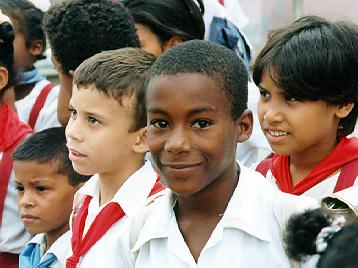
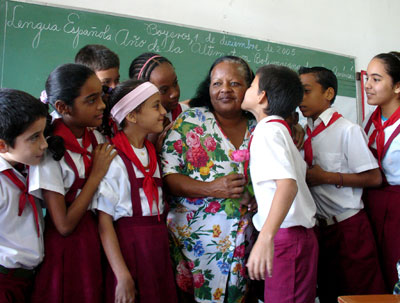
Views
Information
Search
This site made manifest by dadaIMC software


